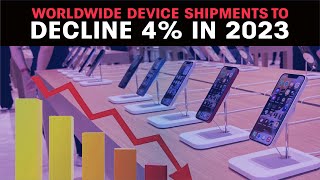Most of the other major PC makers experienced business decline, with most in double digit territory. Whereas, Gartner says that, the worldwide PC shipments were down 19.6%, again with comparable losses for competitors, but with another big discrepancy in the Apple number with Gartner finding it falling 15.6% year over year.
As per Canalys, adverse macroeconomic and industry factors including high inflation, rising interest rates and bloated channel inventories have dented the PC market’s momentum, and are likely to persist into 2023. Notebook shipments suffered the most, posting a year-on-year decline of 19% with 54.7 million units shipped. Desktop shipments proved more robust due to less reliance on consumer spending, falling 11% year-on-year for a total of 14.7 million units.
Lenovo maintained pole position in the global PC market but suffered a 16% year-on-year drop to 16.9 million units. For the second quarter in a row, HP underwent the largest decline out of the top five vendors as it posted 12.7 million units, a 28% year-on-year fall.
Both Lenovo and HP shipped their lowest totals since the onset of the pandemic in Q1 2020. Third-placed Dell also posted a significant decline of 21% in shipments, posting just under 12 million units.
Apple enjoyed a better quarter than its competitors as it fulfilled orders from Q2 delayed due to supply disruptions in China and launched new M2 Macbooks. It sealed fourth place with 8.0 million units, a modest year-on-year increase of 2%. Asus rounded out the top five with 5.5 million units, an annual decrease of 8%.
PC sales posted their fastest growth in 20 years during the first quarter of 2021 as consumers and businesses bought new laptops and desktops for remote work and learning. In 2021, PC sales grew about 15%, returning to 2012 levels after nearly a decade of slow or no growth.
Companies allowed employees to log into their systems with hastily deployed VPNs without ha.

Most of the other major PC makers experienced business decline, with most in double digit territory. Whereas, Gartner says that, the worldwide PC shipments were down 19.6%, again with comparable losses for competitors, but with another big discrepancy in the Apple number with Gartner finding it falling 15.6% year over year.
As per Canalys, adverse macroeconomic and industry factors including high inflation, rising interest rates and bloated channel inventories have dented the PC market’s momentum, and are likely to persist into 2023. Notebook shipments suffered the most, posting a year-on-year decline of 19% with 54.7 million units shipped. Desktop shipments proved more robust due to less reliance on consumer spending, falling 11% year-on-year for a total of 14.7 million units.
Lenovo maintained pole position in the global PC market but suffered a 16% year-on-year drop to 16.9 million units. For the second quarter in a row, HP underwent the largest decline out of the top five vendors as it posted 12.7 million units, a 28% year-on-year fall.
Both Lenovo and HP shipped their lowest totals since the onset of the pandemic in Q1 2020. Third-placed Dell also posted a significant decline of 21% in shipments, posting just under 12 million units.
Apple enjoyed a better quarter than its competitors as it fulfilled orders from Q2 delayed due to supply disruptions in China and launched new M2 Macbooks. It sealed fourth place with 8.0 million units, a modest year-on-year increase of 2%. Asus rounded out the top five with 5.5 million units, an annual decrease of 8%.
PC sales posted their fastest growth in 20 years during the first quarter of 2021 as consumers and businesses bought new laptops and desktops for remote work and learning. In 2021, PC sales grew about 15%, returning to 2012 levels after nearly a decade of slow or no growth.
Companies allowed employees to log into their systems with hastily deployed VPNs without ha
Technology video | 146 views

Worldwide wearable band shipments dropped to four percent to 41.7 million units in Q1 2022, as per the estimate of Canalys. At the same time, the shift from bands to watches continues. Wristwatches, consisting of basic watches and smartwatches, accounted for 76.6% of all wearable band shipments in the quarter, growth of 15% to 32.0 million units. Basic bands suffered a 37% decline, a sixth consecutive fall since Q4 2020. Basic band shipments dipped below 10 million for the first time after peaking at 27.9 million in Q4 2019. The increase in watch shipments helped offset the basic band drop but still resulted in a decline in the overall wearable band market. The rise of basic watches accelerated the shift from bands to watches. Basic watches run rudimentary real-time operating systems but lack support for third-party apps, as opposed to smartwatches, which run fully-fledged operating systems with third-party app support. “Consumers are favoring watches over bands. With bigger displays, richer features and longer battery life, they believe watches are better able to fulfill their health-tracking and digital lifestyle needs. “Basic watches are positioned as an affordable step-up from basic bands, suitable for price-conscious consumers with growing expectations as to what wearables can do.”
The consumer survey report states that, the survey conducted in April 2022, out of 4,000 respondents from four Western European markets, 34% said they intended to buy a smartwatch in the next 12 months, against 17% who would choose a fitness band. Smartwatches stood out as the most popular companion device to smartphones for Western European consumers. The future consumer demand will shift away from basic bands to watches, potentially affecting vendors such as Xiaomi and Fitbit, which are still shipping basic bands in significant numbers. Apple maintained its lead in the wristwatch segment, driven by strong demand for the Watch Series 7. “Despite growing 53%, Samsung was bea
Technology video | 238 views

The depressed economic market will continue to dampen demand for devices throughout 2023. In fact, end-user spending on devices is projected to decline 5.1% in 2023. Experts say, iust as business confidence was beginning to recover after the worst of the pandemic, it has now fallen significantly in most regions. We do not expect relief from inflation and the bottom of the recession to occur until the fourth quarter of 2023.
The downward trend affecting the devices market will lessen in 2023 on the expectation of a less pessimistic economic outlook through 2023, eventually increasing consumer and business spending.
Secondly, PC shipments will continue to record the worst decline of all device segments in 2023. PC shipments are estimated to decline 6.8% in 2023, after a 16% decline in 2022.
Through 2023, PC vendors will reduce inventory levels and Gartner analysts expect PC inventory levels will return to normal by the second half of 2023 after significantly increasing in 2022. “Inventory levels increased due to vendors overestimating market demand and because of the collapse in consumer confidence and dramatic fall in demand,” say experts.
In 2022, while many business PCs could upgrade to the Windows 10 operating system), many did not. By the end of 2023, Gartner expects more than 25% of business PCs will upgrade to Windows 11. However, Windows 11 will not drive enough sales to reach the same volumes seen between 2020 and 2022. In addition, as high inflation rates and impending recession decrease discretionary spend and budgets, Gartner estimates consumers and businesses will extend their PC and tablet replacement cycles by over 9 months by the end of 2023.
Gartner forecasts worldwide smartphone shipments to decline 4% in 2023. Smartphone shipments are projected to total 1.230 billion units in 2023, down from 1.280 billion units in 2022.
At the same time, consumers are holding onto their phones longer than expec
Technology video | 355 views

The depressed economic market will continue to dampen demand for devices throughout 2023. In fact, end-user spending on devices is projected to decline 5.1% in 2023. Experts say, iust as business confidence was beginning to recover after the worst of the pandemic, it has now fallen significantly in most regions. We do not expect relief from inflation and the bottom of the recession to occur until the fourth quarter of 2023.
The downward trend affecting the devices market will lessen in 2023 on the expectation of a less pessimistic economic outlook through 2023, eventually increasing consumer and business spending.
Secondly, PC shipments will continue to record the worst decline of all device segments in 2023. PC shipments are estimated to decline 6.8% in 2023, after a 16% decline in 2022.
Through 2023, PC vendors will reduce inventory levels and Gartner analysts expect PC inventory levels will return to normal by the second half of 2023 after significantly increasing in 2022. “Inventory levels increased due to vendors overestimating market demand and because of the collapse in consumer confidence and dramatic fall in demand,” say experts.
In 2022, while many business PCs could upgrade to the Windows 10 operating system), many did not. By the end of 2023, Gartner expects more than 25% of business PCs will upgrade to Windows 11. However, Windows 11 will not drive enough sales to reach the same volumes seen between 2020 and 2022. In addition, as high inflation rates and impending recession decrease discretionary spend and budgets, Gartner estimates consumers and businesses will extend their PC and tablet replacement cycles by over 9 months by the end of 2023.
Gartner forecasts worldwide smartphone shipments to decline 4% in 2023. Smartphone shipments are projected to total 1.230 billion units in 2023, down from 1.280 billion units in 2022.
At the same time, consumers are holding onto their phones longer than expec
Technology video | 238 views

USAID COVID-19 Coordinator, Indian Ambassador To US Look After Relief Shipments | Catch News
On May 01, the United States deployed the COVID-19 relief shipments to India. The higher authorities of US oversaw the send-off of 3rd plane carrying critical life-saving supplies to the people of India. USAID COVID-19 coordinator Jeremy Konyndyk, authorities of White House National Security Council and Indian Ambassador to US, TS Sandhu looked after the shipments.
#TSSandhuUSAID #Coronavirus #catchnews #CatchNewsToday
#WashingtonDC
For more videos, subscribe to our channel: https://goo.gl/bkDSLj
Check out Catch News for more news: http://www.catchnews.com/
Follow Catch News here -
Facebook:https://bit.ly/2xD3NKZ
Twitter: https://bit.ly/2NG3rhr
Instagram: https://bit.ly/30mh2vE
--------------------------------------------------------------------------------------------
Also, Follow Catch in Hindi: http://hindi.catchnews.com/
Catch is a contemporary new digital platform about the ideas and events shaping the world. It aims to filter and provide news-on-the-run for an impatient new generation. It offers greater insight for influencers and the deeper consumer of news. When opinions are shrill and polarized, we hope to create a middle ground and build bridges. When there is a set thinking, we hope to stand apart and go against the wind. The world is complex, exciting, layered, evolving, always interesting. We hope to be the same.
Lots of videos and lots more in the pipeline. Stay tuned.
USAID COVID-19 Coordinator, Indian Ambassador To US Look After Relief Shipments | Catch News
News video | 217 views

#Mobikwik #MobiKwikRuPayCard #RatanTata
Impact of Supply chain on Smartphone shipments
The ongoing October-December quarter is expected to see a decline in smartphone sales in the country due to the ongoing supply chain related challenges, resulting in annual shipments below 160 million in 2021, as the report from IDC and the first half of 2022 will remain challenging, with some easing out expected in the latter half of 2022. Vendors/channels will keep an eye on the over-stocking situation in case demand stays limited due to the price hikes by the suppliers and vendors. IDC reveals that, India’s smartphone market registered a year-over-year (YoY) decline of 12% in 3Q21 (Jul-Sep), shipping 48 million units after four consecutive quarters of growth. Much of this can be attributed to component shortages as well as an unusually high 3Q20 comparison base whereas this year’s post-lockdown demand was addressed by July.
During the July-September quarter, the online channels clocked a record high 52% share, although with a 5% YoY shipment volume decline. At the same time, the eTailer sales festivals such as the Big Billion Days on Flipkart and Amazon Great India festival started in early October, even before the Navratri festival this year, continuing until Diwali. Whereas, the offline channels registered an 18% YoY shipment decline. IDC expects online shipments to surpass offline shipments in 2021. The report further says that India was the third-largest 5G smartphone market globally, with 7% of worldwide 5G shipments shipping 10 million units at an ASP of US$401 in 3Q21. IDC believes that a growing dependency on smartphones is triggered by remote work and learning, as well as a subsequent requirement for better quality hardware is pushing consumers to spend more. With continued chip shortages and logistics costs, brands are also compelled to expand upwards in terms of price points across channels,” said the experts of IDC. A report from Counterpo
Technology video | 213 views

#Modi #cryptocurrencies #Cybercrimes
The rising demand for wearable devices
The demand for wearable devices has been on the rise and grew 9.9% during the third quarter of 2021 (3Q21) reaching 138.4 million units, which has increased to 26.5 percent, Unsurprisingly, the shipments for earphones, including the TWS earbuds, increased 26.5 percent, according to new data from the International Data Corporation (IDC). For the first time, the shipments of smartwatches surpassed the shipments of fitness trackers. With this, smartwatches have now become the second-biggest category in wearable devices, accounting for a 4.3 percent increase. Although the pandemic has driven interest in health and fitness tracking, wrist-worn wearables such as watches and wristbands faced challenges during the quarter as these devices were not immune to the supply constraints and shifting demand brought about by the pandemic. While the category has recently been led by Xiaomi's low-cost bands, the company was dethroned by Apple and Huawei in 3Q21 as they tied for first place in the wrist-worn segment. The reason behind the increased shipments of smartwatches is being said to be due to the users’ demand for more powerful features and functions and thus they are gradually shifting towards smartwatches. Also, there isn’t a huge price difference between a smartwatch and a fitness tracker, which is also a factor for the change.
Demand has been slowly shifting away from wristbands towards watches as consumers increasingly want a more capable device as the gap in pricing narrows,' said Jitesh Ubrani, research manager for IDC Mobility and Consumer Device Trackers. 'The number of watches sold for under $100 is now equal to wristbands, which have dominated this price band in the past. Growth amongst Indian and Chinese brands has been leading the low-end watch space while Apple, Huawei, and Samsung maintain a hold at the high-end. Coming to the companies, Apple is
Technology video | 211 views

As per Gartner, this marks the largest quarterly shipment decline since Gartner began tracking the PC market in the mid-1990s. For the entire year, PC shipments reached 286.2 million units in 2022, a 16.2% decrease from 2021 due to recession fears and increased inflation.
Experts feel since many consumers already have relatively new PCs that were purchased during the pandemic, a lack of affordability is superseding any motivation to buy, causing consumer PC demand to drop to its lowest level in years.
At the same time, the enterprise PC market is also being impacted by a slowing economy and at the same time, the PC demand among enterprises began declining in the third quarter of 2022, but the market has now shifted from softness to deterioration. Enterprise buyers are extending PC lifecycles and delaying purchases, meaning the business market will likely not return to growth until 2024.
While Lenovo maintained 24% market share at the top, the company experienced its steepest decline. Lenovo's shipments fell in all regions except in Japan, declining over 30% in EMEA and Latin America.
HP and Dell also experienced historically steep declines. HP was hit hardest in the EMEA market, where shipments decreased 44 per cent year-over-year. For Dell, weak demand in the large business market impacted shipments in the second half of 2022.
The Asia-Pacific market excluding Japan declined 29.4% year-over-year, mainly due to the market in China. The PC industry experienced very unusual ups and downs over the past 11 years. After the extraordinary growth period between 2020 and 2021 due to the pandemic, the market has clearly begun a downward trend which will continue until the beginning of 2024, say experts of Gartner.
Today's Headline in NewsHours
0:00 Intro
2:40 #Google says CCI’s orders “Strike a Blow” for digital adoption
3:07 #Bigtech concerned about Microsoft getting unfair advantage by Activision d
Technology video | 222 views

Falling demand is causing great concern for the entire smartphone supply chain. While component supplies and cost pressures are easing, a few concerns remain within logistics and production, such as some emerging markets’ tightening import laws and customs procedures delaying shipments. Deep collaboration with channels to monitor the state of inventory and supply will be vital for vendors to identify short-term opportunities while maintaining healthy channel partnerships in the long run.
The global smartphone shipments fell by 17 per cent (year on year) in Q4 2022, with entire 2022 shipments declining by 11 per cent to fewer than 1.2 billion, a new report has shown. Despite shrinking demand and manufacturing issues in China’s Zhengzhou, Apple reclaimed the top spot in Q4 and achieved its highest quarterly market share ever at 25 per cent, as per Canalys.
At the same time, Samsung took the number one spot in the fourth quarter for the first time since Q3 2017, shipping 6.7 million units for a market share of 21 per cent. The second place went to vivo, which shipped 6.4 million units, mainly via offline channels. India was better positioned to weather the global downturn than other markets. But domestic consumer spending cooled in the last few months of 2022.
Even during the festive season, the domestic market suffered a fall in transactions, retail spending and electronic imports. In 2022, consumers already had up-to-date technology that they had bought during the pandemic, thereby delaying further purchases. This led to smartphone brands struggling with inventory management because demand was subdued, say analysts.
The Indian economy started to feel the impact of the global economic slowdown toward the end of 2022. We are entering 2023 with economic indicators suggesting a sluggish performance in the short term.
But, in 2024, India is set to hold its general election and the government's strategy will be to boost con
Technology video | 168 views

Global smartphone shipments dipped 17% in Q4 #shorts
Technology video | 136 views

Bigg Boss 18 OPENING VOTING Trend | Vivian Vs Karan Vs Digvijay Kisko Hai Highest Votes
#biggboss18 #avinashmishra #viviandsena
Follow Aditi On Instagram - https://www.instagram.com/pihuaditi/
Bigg Boss 18 OPENING VOTING Trend | Vivian Vs Karan Vs Digvijay Kisko Hai Highest Votes
Entertainment video | 2702 views

Bigg Boss 18 Promo | Wild Card Entries Ne Avinash, Rajat Aur Vivian Ko Phasa Diya
#biggboss18 #avinashmishra #viviandsena
Follow Aditi On Instagram - https://www.instagram.com/pihuaditi/
Bigg Boss 18 Promo | Wild Card Entries Ne Avinash, Rajat Aur Vivian Ko Phasa Diya
Entertainment video | 1420 views

Yeh Rishta Kya Kehlata Hai | Abhir Ko Hoga Kiara Se Pyaar, Show Mein Love Angle
#yehrishtakyakehlatahai #yrkkh
- Stay Tuned For More Bollywood News
☞ Check All Bollywood Latest Update on our Channel
☞ Subscribe to our Channel https://goo.gl/UerBDn
☞ Like us on Facebook https://goo.gl/7Q896J
☞ Follow us on Twitter https://goo.gl/AjQfa4
☞ Circle us on G+ https://goo.gl/57XqjC
☞ Follow us on Instagram https://goo.gl/x48yEy
Yeh Rishta Kya Kehlata Hai | Abhir Ko Hoga Kiara Se Pyaar, Show Mein Love Angle
Entertainment video | 1444 views

Bigg Boss 18 | MID WEEK EVICTION | Shocking Ye Contestant Hoga Evict
#biggboss18 #avinashmishra #viviandsena
Follow Aditi On Instagram - https://www.instagram.com/pihuaditi/
Bigg Boss 18 | MID WEEK EVICTION | Shocking Ye Contestant Hoga Evict
Entertainment video | 1313 views

Yeh Rishta Kya Kehlata Hai | Armaan Ke Karib Aayi Ruhi, Phir Pyaar Me Hui Beqaboo
#yehrishtakyakehlatahai #yrkkh
- Stay Tuned For More Bollywood News
☞ Check All Bollywood Latest Update on our Channel
☞ Subscribe to our Channel https://goo.gl/UerBDn
☞ Like us on Facebook https://goo.gl/7Q896J
☞ Follow us on Twitter https://goo.gl/AjQfa4
☞ Circle us on G+ https://goo.gl/57XqjC
☞ Follow us on Instagram https://goo.gl/x48yEy
Yeh Rishta Kya Kehlata Hai | Armaan Ke Karib Aayi Ruhi, Phir Pyaar Me Hui Beqaboo
Entertainment video | 1294 views

Yeh Rishta Kya Kehlata Hai | Ruhi Par Bhadka Armaan, BSP Se Dur Rehne Kaha
#yehrishtakyakehlatahai #yrkkh
- Stay Tuned For More Bollywood News
☞ Check All Bollywood Latest Update on our Channel
☞ Subscribe to our Channel https://goo.gl/UerBDn
☞ Like us on Facebook https://goo.gl/7Q896J
☞ Follow us on Twitter https://goo.gl/AjQfa4
☞ Circle us on G+ https://goo.gl/57XqjC
☞ Follow us on Instagram https://goo.gl/x48yEy
Yeh Rishta Kya Kehlata Hai | Ruhi Par Bhadka Armaan, BSP Se Dur Rehne Kaha
Entertainment video | 1291 views

IND vs SA | World Cup T20 2024 | Match Preview and Stats | Fantasy 11 | Crictracker
Welcome to the exhilarating showdown between India vs South Africa in the World Cup T20 2024 season! Get ready for an electrifying clash as these two powerhouse teams, fueled by raw talent and strategic brilliance, lock horns for cricketing supremacy.
Join us as the India, led by their charismatic captain, face off against the South Africa, determined to showcase their prowess on the pitch. With star-studded lineups boasting top-tier international players and emerging talents, expect nothing short of cricketing excellence and heart-stopping moments.
Don't miss a single moment of the action, drama, and excitement as these teams battle it out in the high-stakes arena of World Cup T20 2024. From breathtaking boundaries to strategic masterstrokes, witness every twist and turn in this epic showdown.
IND vs SA | World Cup T20 2024 | Final | Match Preview and Stats | Fantasy 11 | Crictracker
Sports video | 11821 views

IND vs ZIM | T20 | Match Preview and Stats | Fantasy 11 | Crictracker
Welcome to the exhilarating showdown between India vs Zimbawe in the T20 series! Get ready for an electrifying clash as these two powerhouse teams, fueled by raw talent and strategic brilliance, lock horns for cricketing supremacy.
Join us as the India, led by their charismatic captain, face off against the Zimbawe, determined to showcase their prowess on the pitch. With star-studded lineups boasting top-tier international players and emerging talents, expect nothing short of cricketing excellence and heart-stopping moments.
Don't miss a single moment of the action, drama, and excitement as these teams battle it out in the high-stakes arena of this T20 series. From breathtaking boundaries to strategic masterstrokes, witness every twist and turn in this epic showdown.
IND vs ZIM | T20 | Match Preview and Stats | Fantasy 11 | Crictracker
Sports video | 2333 views

Watch as our employees try to guess the famous cricketers from just a few clues. Can you beat them at their own game? Test your cricket knowledge and see how many cricketers you can guess correctly. Don’t forget to like, comment, and subscribe for more fun office challenges and cricket trivia! #CricketChallenge #OfficeFun #guessthecricketer #crickettrivia
Office Fun Challenge: Guess the Cricketers? #office #crictracker #cricketlover ????
Sports video | 1604 views

IND vs BAN | T20 | Match Preview and Stats | Fantasy 11 | Crictracker
Welcome to the exhilarating showdown between India vs Bangladesh in the T20 series! Get ready for an electrifying clash as these two powerhouse teams, fueled by raw talent and strategic brilliance, lock horns for cricketing supremacy.
Join us as the India, led by their charismatic captain, face off against the Bangladesh, determined to showcase their prowess on the pitch. With star-studded lineups boasting top-tier international players and emerging talents, expect nothing short of cricketing excellence and heart-stopping moments.
Don't miss a single moment of the action, drama, and excitement as these teams battle it out in the high-stakes arena of this T20 series. From breathtaking boundaries to strategic masterstrokes, witness every twist and turn in this epic showdown.
IND vs BAN | T20 | Match Preview and Stats | Fantasy 11 | Crictracker
Sports video | 3031 views

IND vs SL | T20 | Match Preview and Stats | Fantasy 11 | Crictracker
Welcome to the exhilarating showdown between India vs Sri Lanka in the T20 series! Get ready for an electrifying clash as these two powerhouse teams, fueled by raw talent and strategic brilliance, lock horns for cricketing supremacy.
Join us as the India, led by their charismatic captain, face off against the Sri Lanka, determined to showcase their prowess on the pitch. With star-studded lineups boasting top-tier international players and emerging talents, expect nothing short of cricketing excellence and heart-stopping moments.
Don't miss a single moment of the action, drama, and excitement as these teams battle it out in the high-stakes arena of this T20 series. From breathtaking boundaries to strategic masterstrokes, witness every twist and turn in this epic showdown.
IND vs SL | T20 | Match Preview and Stats | Fantasy 11 | Crictracker
Sports video | 2657 views

IND vs SL | T20 | Final | Match Preview and Stats | Fantasy 11 | Crictracker
Welcome to the exhilarating showdown between India vs Sri Lanka in the T20 series! Get ready for an electrifying clash as these two powerhouse teams, fueled by raw talent and strategic brilliance, lock horns for cricketing supremacy.
Join us as the India, led by their charismatic captain, face off against the Sri Lanka, determined to showcase their prowess on the pitch. With star-studded lineups boasting top-tier international players and emerging talents, expect nothing short of cricketing excellence and heart-stopping moments.
Don't miss a single moment of the action, drama, and excitement as these teams battle it out in the high-stakes arena of this T20 Final. From breathtaking boundaries to strategic masterstrokes, witness every twist and turn in this epic showdown.
IND vs SL | T20 | Final | Match Preview and Stats | Fantasy 11 | Crictracker
Sports video | 2292 views